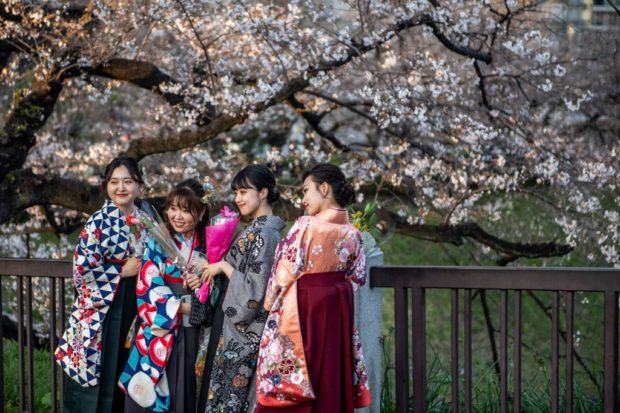
People wearing hakama, a traditional outfit for university graduation ceremonies, pose for pictures underneath cherry blossoms at Kitanomaru Park in Tokyo on March 23, 2021, as the country’s famed cherry trees began their annual bloom nearly two weeks ahead of schedule. (Photo by Philip FONG / AFP)
TOKYO — People in Tokyo flocked to admire cherry blossoms in full bloom at parks, shrines, and rivers on Friday, despite coronavirus warnings against holding traditional parties under the delicate flowers.
Annual festivals have been canceled, fluorescent tape used to cordon off picnic spots, and signs put up urging people to “refrain from gathering to enjoy the cherry blossoms.”
But many people, mostly wearing masks, decided to make the most of Friday’s clear blue skies to snap “sakura” selfies, stroll down blossom-lined paths or take boat rides under the pink-and-white blooms.
Despite the third wave of COVID-19 infections over the winter, Japan has had a comparatively small outbreak overall with around 9,000 deaths and has not imposed the blanket lockdowns seen in other countries.
The Japanese government this week lifted a virus state of emergency in the Tokyo area but city governor Yuriko Koike has warned residents to “avoid cherry blossom viewing parties” to prevent a resurgence of the disease.
A couple take pictures with the background of cherry blossoms in Meguro district of Tokyo on March 23, 2021, as the country’s famed cherry trees began their annual bloom nearly two weeks ahead of schedule. (Photo by Philip FONG / AFP)
The number of coronavirus cases in Tokyo is gradually rising, with 394 new infections recorded on Thursday.
“We fear there may be a sudden spread of infections — bigger than the third wave — if the number of people going out increases, as it does each year with cherry blossom viewing, welcome parties (for new employees and students) and graduation trips,” said Norio Ohmagari, director of Japan’s Disease Control and Prevention Center, on Thursday.
Japan’s sakura or cherry blossom season is feverishly anticipated by locals and visitors alike, although this year foreign tourists have been kept away by virus border restrictions.
Cherry blossoms symbolize the fragility of life in Japanese culture as full blooms only last about a week before the petals start falling off trees.
It is traditionally celebrated with hanami, or viewing parties, with picnics — and sometimes boozy festivities — organized beneath the trees.
The season is also considered one of change as it marks the start of the new business year, with many university graduates starting their first full-time jobs and older colleagues shifting to new positions.